After narrowly missing out on promotion to the Belgian Pro League last season, where they lost in the promotion/relegation playoff to RFC Seraing, RWD Molenbeek are on the verge of a return to the Belgian top flight. With the Challenger Pro League currently in the promotion playoff period, Molenbeek sit top of the league, three points clear of SK Beveren.
The club has gone through changes recently, getting relegated the last time they were in the Belgian top flight because of license issues. This forced them to essentially go bust and reform, which placed them in the fifth tier of Belgian football.
In 2015, two clubs that previously folded merged together, Standaard Wetteren and RWDM, which then became known as the club in its current iteration. That was the start of their new journey, with it now becoming exciting, as in 2021, the club was purchased by American businessman John Textor, who also owns Crystal Palace, Botafogo, and Lyon. Now, under the guidance of former Cercle Brugge and Leuven manager Vincent Euvrard, the club are on the verge of making it into the top flight once again.
This tactical analysis and scout report will look at the success the club has had under the Belgian manager, and also look ahead to the future for the Brussels-based side.
Formations
When it comes to the formations that Euvrand has typically lined up his Molenbeek side up in, the image below shows the range of formations that have been utilised this season.
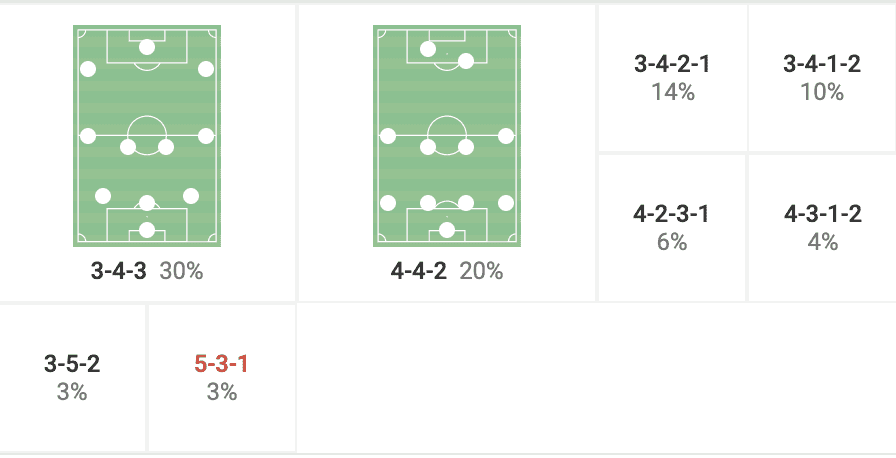
As the image above shows, the Belgian manager has typically lined his Molenbeek side up in some variation of a three-at-the-back formation, with 57% of the time being in some variation. However, it normally is a 3-4-3, with the formation shifting to a five-back at times during the defensive phases of play. Euvrand has also used a 4-4-2 relatively often, but in more recent fixtures in the Challenger Pro League promotion playoffs, it has been the 3-4-3. As this tactical analysis progresses, we will look at some of the tactics that Vincent Euvrand has used to great success this season.
Pressing with the front three to great success
One tactic that Vincent Euvrand has successfully implemented this season is the high line of confrontation from the front three during pressing moments. In fact, RWD Molenbeek are statistically one of the best pressing sides in the Challenger Pro League this season, with the graphic below highlighting this.

The graphic above shows the number of ball recoveries that Molenbeek have made in an advanced area throughout this current Challenger Pro League season. Their 288 high regains are the most in the division, with them also having one of the highest numbers of counterpressing recoveries (412) and dangerous recoveries (123). A lot of this high pressing is done by the front three, with them looking to put pressure on the centre-backs instantly after they gain possession, whether from a build-up from the goalkeeper, or in a counter-pressing situation for Molenbeek.
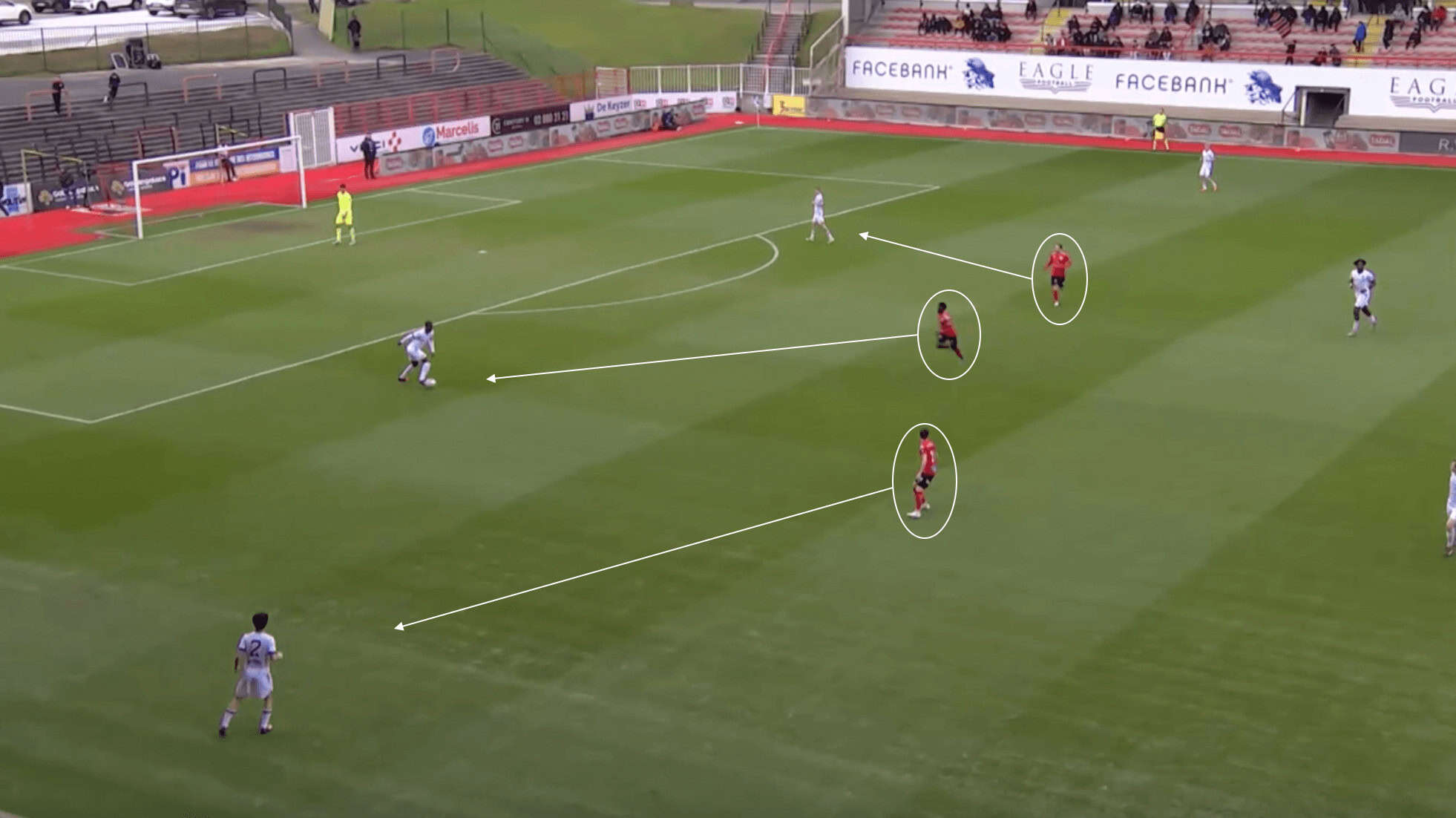
The image above shows an example of this high pressing from the Molenbeek front three to force the opposition defenders into a turnover. As the ball finds its way back to the Club Brugge II central defenders, this triggers the Molenbeek forwards to go and seek out the ball, with the rest of the defensive shape pushing forward to keep the opposition pinned into their own half.
The centrally positioned forward puts pressure on the central defender in possession, causing him to take a heavy touch and lose possession in an advanced area. As a result, the Molenbeek forward is able to win the ball back and start a transitional attacking moment, which allows them the opportunity to create a goalscoring chance from this dangerous recovery.
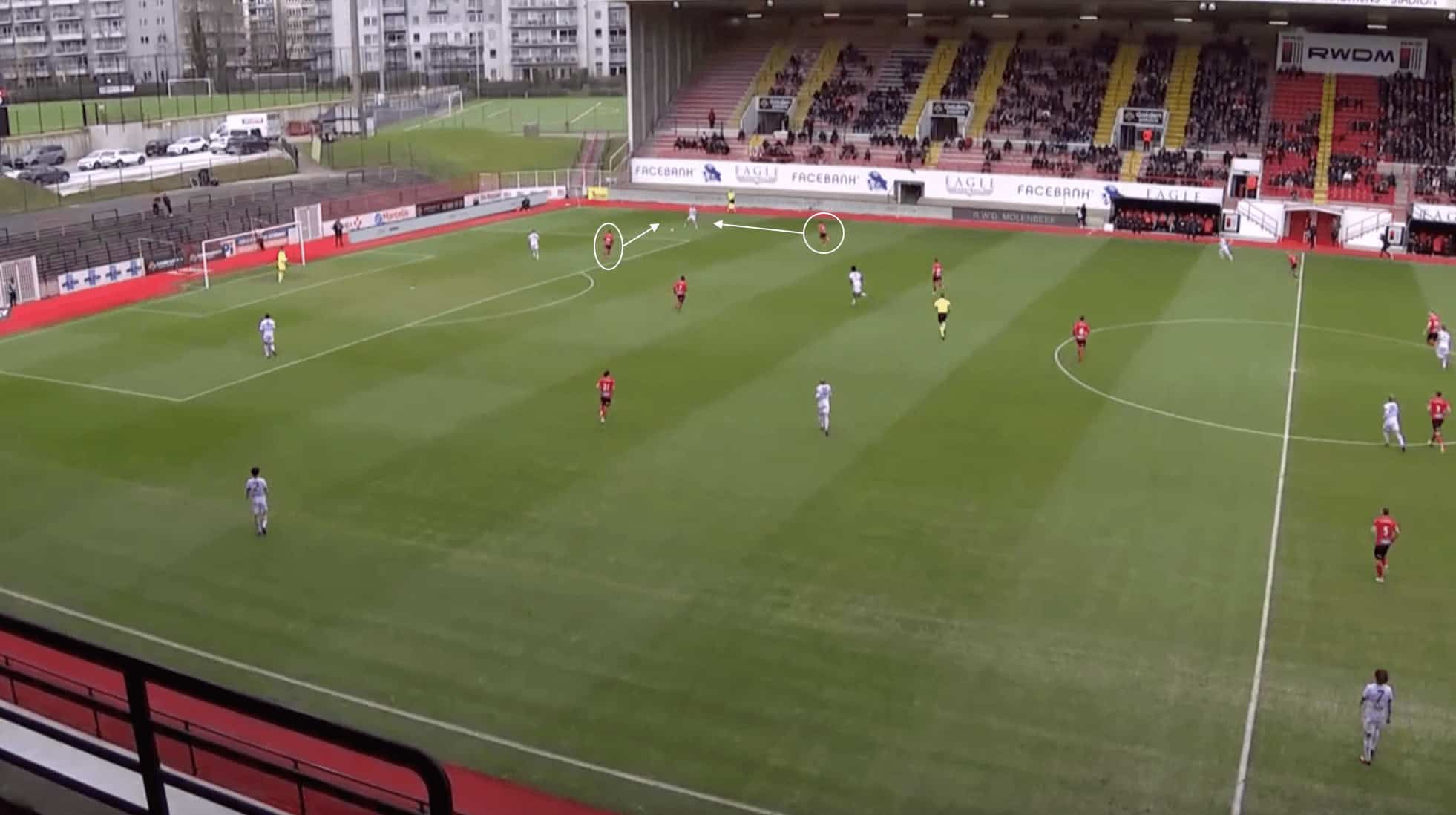
The image above shows another example of the pressing of the forwards impacting the decision-making of the opposition defenders when they are in possession. In the phase of play above, Club Brugge II are looking to build out from the back, with the ball beginning in the possession of the goalkeeper.
As the ball is played to the central defenders, the forwards are able to force it to one side, which results in the advanced Molenbeek players engaging the fullback when he receives possession, with the resulting pressure forcing the ball to go out of play for an opposition throw-in deeper in their own half.
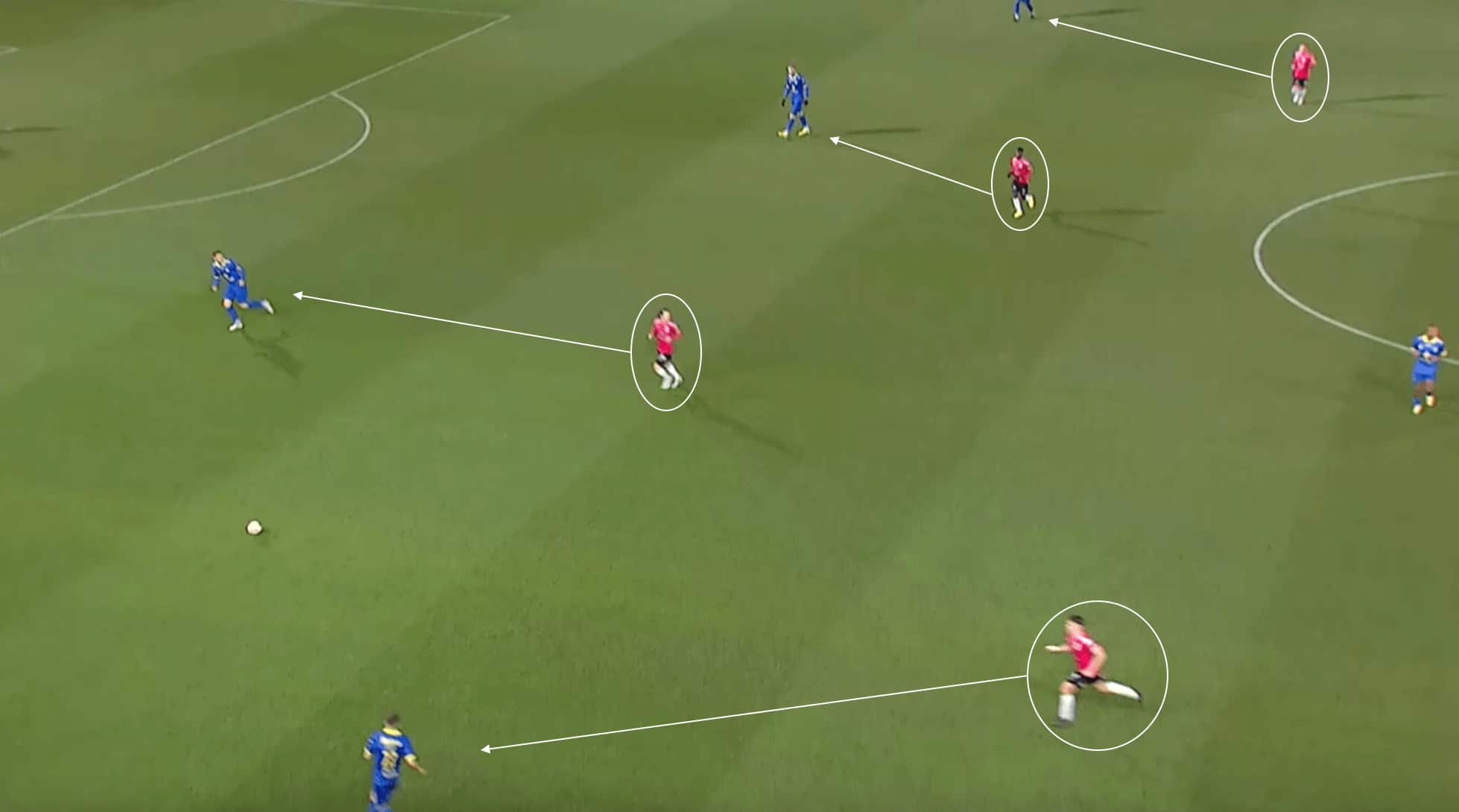
The image above shows the numbers that Molenbeek pushes forward when they are in a pressing phase of play. In the match above against title challengers SK Beveren, the Molenbeek forwards are all in advanced positions, essentially man-marking the Bevern defenders. As the ball is played to the fullback out wide, the wide midfielder goes and engages the defender, with the resulting pressure forcing the defender to play the ball long and into the hands of the Molenbeek defenders.
As this section has illustrated, the three forwards in Vincent Euvrard’s 3-4-3 formation always look to put pressure on the opposition’s defence when they are in possession, with them usually looking to match the defenders up man-to-man. This style of pressing also allows the midfielders of Molenbeek to push into these advanced positions, with the Belgian side statistically one of the best pressing sides in the Challenger Pro League.
Sending balls in from the wide area when attacking
When it comes to an attacking perspective for Molenbeek, Euvrand’s side are one of the highest crossers in the league, with their 445 second to only Standard Liège II who have sent 451 crosses into the penalty box this season from the wide areas. They also send in the second most crosses per 90 minutes, once again only Standard Liège II have more per 90 minutes.
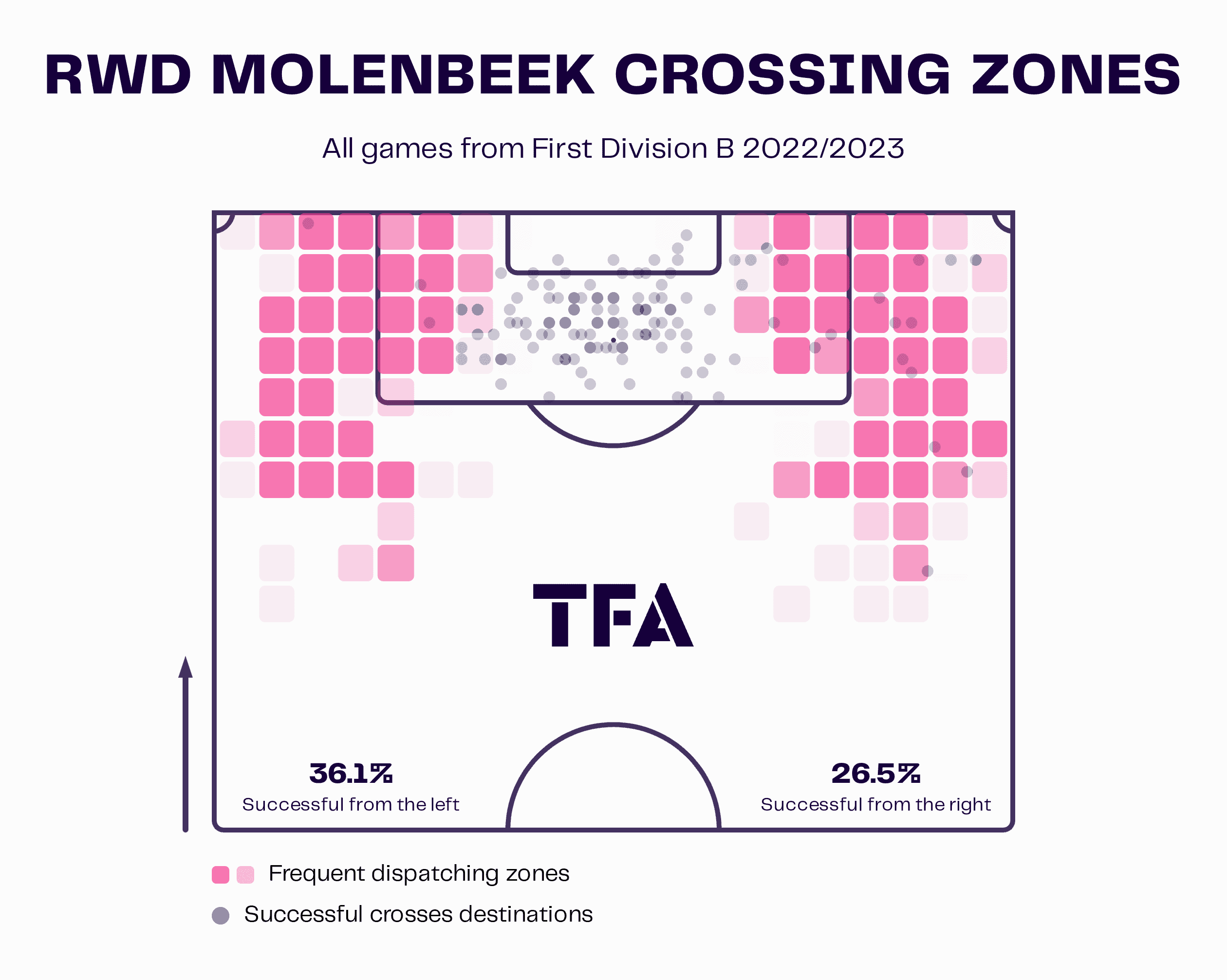
As the data viz above shows, the majority of the successful crosses for Molenbeek this season have occurred from the left side, with a relatively high 36.1% being successful from this side. They also have successfully completed 26.5% from the right, which while not nearly as good as the opposite side, is still pretty respectable.
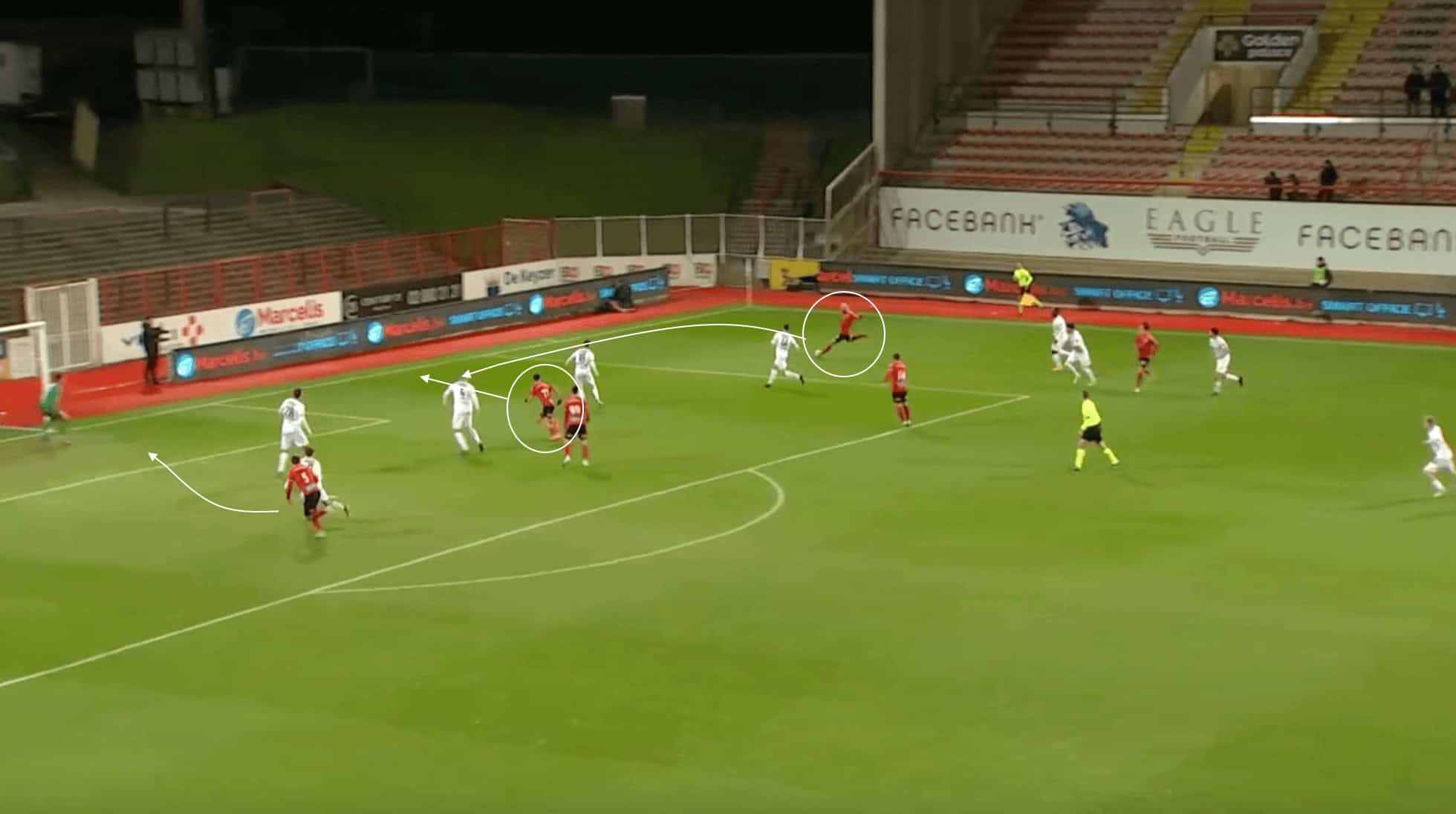
The image above shows an example of the crossing ability from wide areas that Molenbeek possesses. In the phase of play above, after a quick one-touch passing sequence, the ball is sent into the box from the wide area from the Molenbeek wide midfielder. Two Molenbeek attackers are able to make good runs from the edge of the penalty box all the way towards the edge of the six-yard box.
One of the forwards makes a run between the two opposition defenders, which makes him an option at the near post area. The other attacker makes a run from the back shoulder of the last defender, aiming his run towards the far post area.
The ensuing cross is aimed towards the front post, with the ball reaching the player making his run towards this near post area. He is able to make contact with the ball, but unfortunately, no good goal-scoring chance is generated from this cross.
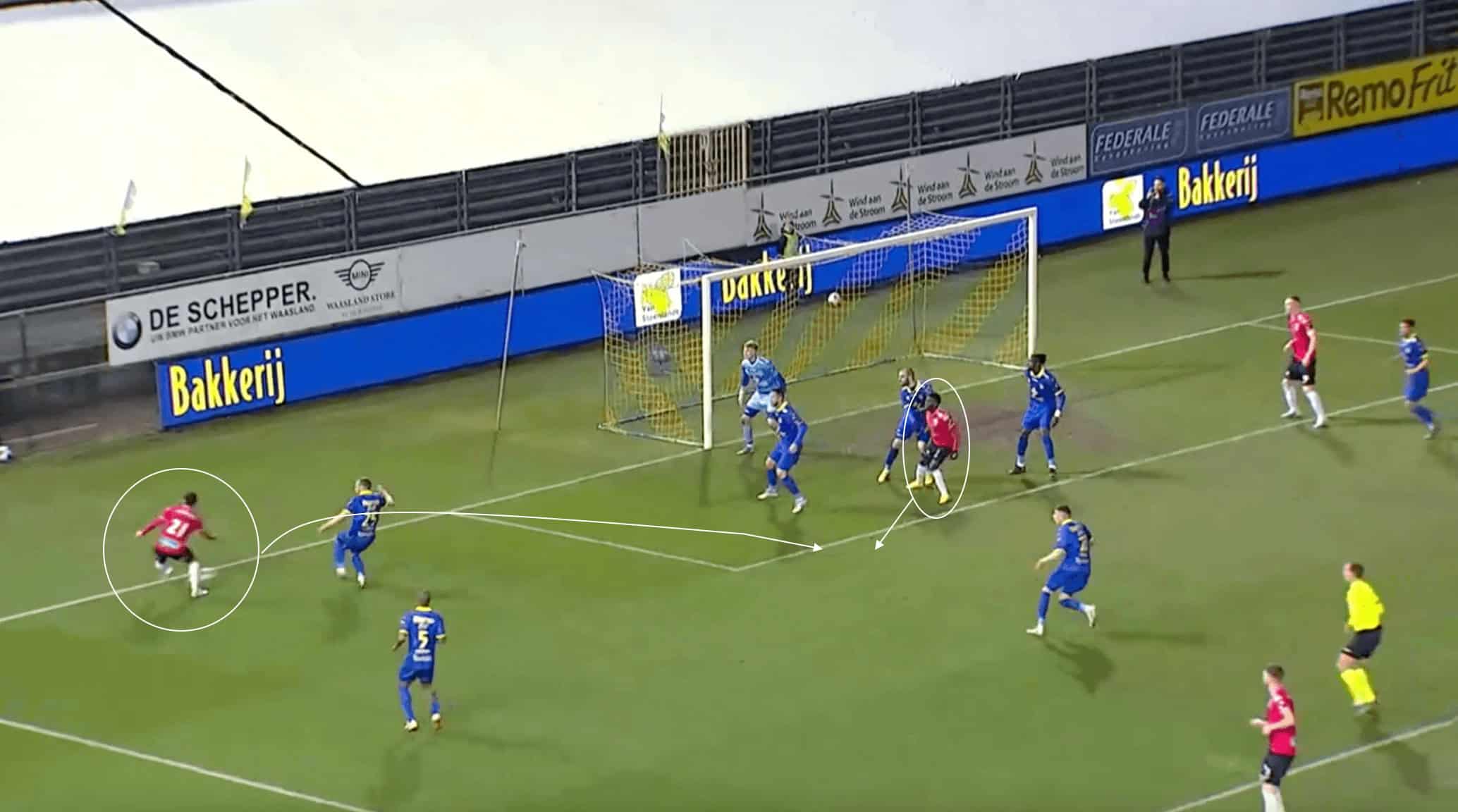
The image above shows another example of Molenbeek’s ability to create chances from crossing, with the phase of play above resulting in a shot that is relatively close to sneaking in at the near post. The wide midfielder is able to get to the byline after some good footwork to get on the wrong side of the defenders. The striker who is positioned on the edge of the six-yard box is able to cut back from his current position to the edge of the box, making himself an option for a cutback pass in the process.
After reaching the byline, the wide midfielder is able to send a cross into the crowded area, with the pass being sent to the perfect area after the striker drops off into the space. The striker is then able to quickly get a shot off, which goes just wide of the goalkeeper’s near post.
As this section has shown, the use of crossing from the wide areas has had relatively good success for Molenbeek this season, with it being one of the reasons that the Belgian side are on the verge of being promoted into the top tier of Belgian football.
Where could they improve if they get promoted?
When taking a look at Molenbeek’s squad for next season, there will definitely be work that needs to be done if the team are promoted to the Belgian Pro League next season. About one-third of the Molenbeek starting XI this season are on loan, so unless they can get these players in permanently, then work will have to be done to replace them. One of those players on loan is Brazilian central midfielder Camilo, who is actually on loan from Lyon, another club owned by John Textor.
It is likely that if Molenbeek get promoted they will look to add loan signings from the other clubs owned by Textor, which include French side Lyon, Brazilian side Botofago and English Premier League side Crystal Palace, who are managed by former Arsenal and Juventus midfielder Patrick Vieira. With most newly promoted clubs in the Belgian Pro League not having a large amount of money to spend, it would not be surprising to see the club just look to bring in plenty of loans from other clubs within their owner’s umbrella.
In general, it would be likely if the club looked to strengthen at all positions next season, granted they get into the Belgian Pro League next season. They already have a decent squad in place for next season, with a lot of their youngest talent still under contract for next season, with one of those including Real Madrid winger Eden Hazard’s brother, Kylian.
Conclusion
This tactical analysis and scout report has taken a look at just a couple of the tactics that Vincent Euvrard has utilised to great success with RWD Molenbeek in their promotion attempt this season. It will also be interesting to see another club based in Brussels in the Pro League next season if they manage to complete the job in the upcoming weeks.





Comments